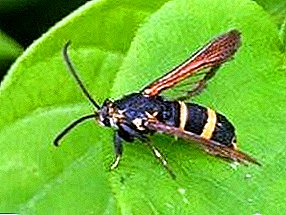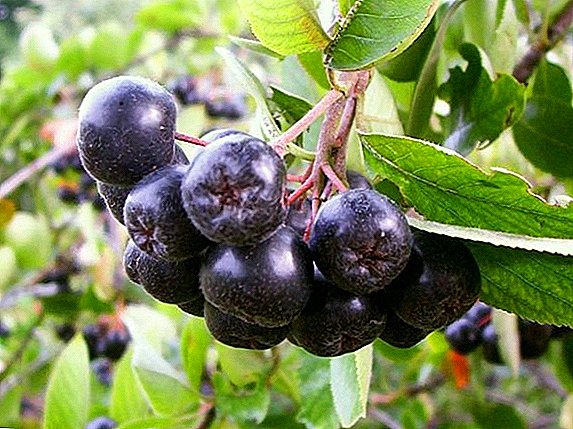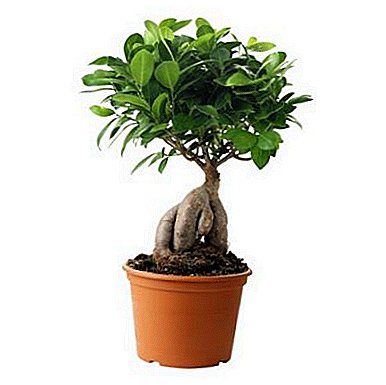
Ginseng It is considered to be one of the most popular ficus.
Among the wide variety of its relatives, it attracts attention with an unusual outlandish root, giving the plant a fantastic look.
The tree is also known for its unpretentiousness and endurance.
Description
Ginseng, he microcarp or small-fruited ficus belongs to the family of the Mulberry.
In Latin, its scientific name sounds like Ficus microcarpa ginseng.
Under natural conditions, it is an evergreen tree. 15-25 meters high with a thick spreading crown, a powerful trunk and huge aerial roots hanging down.
In room culture most often it is grown in the form of a bonsai with a small stem, but a huge rhizome, shaped like ginseng root. Not by chance "ginseng" is translated as "ginseng."
The tropics and subtropics of Southeast Asia are the habitat of the tree.
This representative of the flora is also called the "Indian laurel", "green island" and "Chinese banyan".
Its dark green leathery leaves are rather large - up to 15 cm in length.
They are oval in shape and have a glossy surface.
 Ginseng is a ficus strangler.
Ginseng is a ficus strangler.
Starting life as an epiphyte, as it develops it takes root next to the host tree, braids it and stifles it, preventing it from developing.
A bizarre rhizome, which is famous for indoor ficus ginseng, is not found in nature.
It is grown on farms using a special technology that is kept secret.
The tree is fed with special preparations and contain in special conditions.
Towhen the root reaches the desired thickness and shape, the plant is transplanted into another container, leaving most of the rhizomes on the ground surface.
At the same time cut off the trunk and grow new greens.
Bred on farms and indoor forms with an ordinary trunk.
In this case, the rhizome is hidden in the ground and the luxurious dense crown gives the main beauty of the tree.
Home care
Ficus ginseng differs in unpretentiousness in leaving and endurance.
Performing simple rules of care will help him develop well, not get sick and be protected from attacks of pests.
Important - The trunk of the tree is covered with a thin gray-brown bark, when damaged, white milky juice is released.It is advisable to prevent such injuries when caring for a “green friend” - the wounds on the trunk heal for a very long time.
Temperature
The tree prefers diffused light or partial shade.
The ideal place is near the window, but as far as possible from the heating devices.
Important - It is advisable once and for all to decide on a permanent place of the ficus, because he does not like to travel and in response can lose leaves.
The most comfortable temperature for this representative flora - from 20 to 23 ° C.
In the hot season will require regular airing. At the same time drafts are very undesirable.
In winter, the temperature column in the room must not fall below 16 ° C.
Watering and moisture
 From spring to autumn, abundant watering is required, but without undue diligence, and in winter - moderate.
From spring to autumn, abundant watering is required, but without undue diligence, and in winter - moderate.
Over-wetting of the soil can lead to rotting of the roots.
The need for watering is determined easily: drying the top layer of soil to a depth of about 3 cm - a signal that it is time to moisten the soil.
It is important to ensure that the earth does not dry out completely and the water in the pan does not stagnate.
The tree needs high humidity.
It will be very grateful for the daily spraying in the mornings and evenings.
Water for this is better to take boiled, otherwise there will be a white bloom on the leaves.
Also, the plant will not give up a warm shower once a month and regularly wipe the leaves with a damp cloth.
It is desirable that during the water procedures on the trunk fell as little as possible water.
To increase the humidity, you can use a wet pebble tray.
Top dressing
From March to mid-October, it is recommended to feed every two weeks a “green friend” with a mineral complex or a special fertilizer for bonsai.
In winter, feeding is reduced to once a month.
Fertilizers should be applied with irrigation in moist soil.
Bloom
The tree blooms with small flowers, which bloom inside the spherical receptacle.
Later they are transformed into fruits, the so-called syconia, shaped like large berries.
At home, the tree is covered with flowers extremely rarely and, moreover, does not bear fruit, since it must be pollinated by small wasps that live only in its homeland.
Crown formation
 Ficus mikrokarp very plastic shoots, so his crown can be given any shape.
Ficus mikrokarp very plastic shoots, so his crown can be given any shape.
If the appearance of the purchased copy is quite satisfactory, you can save it by regularly pinching the tips of the branches.
To form a branched crown, the top of the tree is cut, leaving no more than 5 cm length of branches.
An interesting form of the crown is obtained if you select one strong branch that grows in any direction and does not hinder its development.
The direction of the branches is sometimes formed with the help of a wire.
To get a powerful barrel it is cut several times.
It is said that together with this procedure, a large number of leaves are also removed, which reduces the need of the plant for moisture.
Transfer
"Indian laurel" needs a loose and fertile soil with acidity pH from 5.5 to 7.5.
You can buy a special substrate for ficus or prepare it yourself from equal parts of coarse sand, peat, turf and leafy land with the addition of fine charcoal.
Another option for a suitable substrate - sand, humus and clay granules taken in equal parts.
Young specimens are transplanted every year or one year in early spring with full replacement of the ground, and adults - once in 2-3 years by transfer.
Care after purchase
In the first two weeks after the purchase, the tree often drops the foliage - thus it reacts to a change of residence.
This is not scary - with regular watering and spraying, the “newcomer” will soon adapt and release fresh leaves.
To get used to new conditions more quickly, it is useful to spray it with a solution once a week. "Appin".
But this is done only a couple of weeks after he settles.
Photo
In the photo ficus "Ginseng":

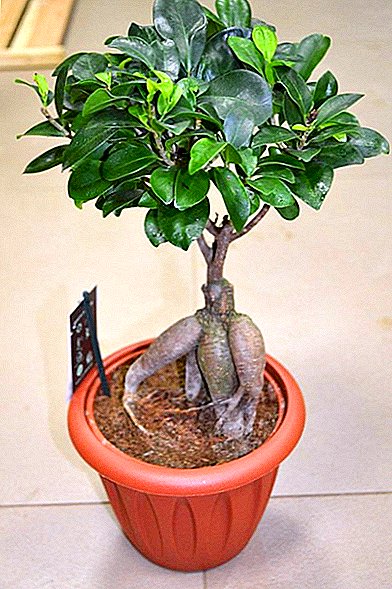
Breeding
Cuttings
In the spring from the tops of the shoots cut semi-woody cuttings 15 cm long and put them in water for a couple of hours so that the milky juice was washed away.
Next, the cuttings are dried and planted in a peat-sand mixture with vermiculite, covered with a plastic bag and placed on a bright shaded place.
Before planting, the substrate is disinfected by heating in an oven or chilled in a fridge.
Rooting occurs within 2 months after which the seedlings are transplanted into separate pots.
Root cuttings
In an adult specimen, a piece of root is cut, which is planted in the substrate, leaving 2.5 cm its upper part to rise above the ground surface.
Next, the root cutting together with the container covered with a film.
When watering once a week and regularly airing in 3-4 months you can expect new shoots.
After the appearance 4-5 leaves remove the film and put a young bush on a bright place with shading and provide him with proper care.
Air layouts
 From the trunk remove a ring of bark width from 2 to 3 cm.
From the trunk remove a ring of bark width from 2 to 3 cm.
The incision site is covered with wet sphagnum moss and covered with polyethylene.
Next, the moss is constantly kept wet.
After the roots appear in this place, the upper part of the bonsai is cut together with the new root system and planted in another pot.
This method is used to rejuvenate copies that have lost their decorative effect.
Seeds
A rare method, as it is difficult to get seeds.
Sowing of seeds is carried out in a substrate consisting of peat and sphagnum moss.
They germinate quite long in "mini greenhouse" and constantly moistened substrate.
Important - It should be borne in mind that with any method of reproduction the result will be a ficus with a normal stem and a closed root system.
To get a powerful outdoor root at home is extremely difficult.
As already described above, this requires a special cultivation technology.
Diseases and pests
The tree often suffers from improper care.

The following problems may occur:
- Green leaves are falling - poor lighting, drafts, temperature drops, waterlogging of the soil, change of place.
- The leaves turn yellow first, and then fall off - insufficient watering, low humidity, poor lighting in the winter.
- Lower leaves turn yellow - lack of nutrients.
- Dark spots appear on the foliage and root rot develops - stagnant water in the soil.
When establishing proper care, the problems disappear: the green pet quickly recovers and becomes overgrown with new leaves.
If the tree is affected by root rot, you should immediately start treatment.
You need to get it out of the pot, remove all the diseased parts of the root and cut off part of the crown, so that the patient pays all his strength for recovery.
Next, you should transplant it into a new substrate and pour it with a solution of fungicide.
Dangerous enemies:
- Spider mite
- Shchitovka
- Mealybug.
When pests are detected, treatment with insecticides is carried out.
In order to prevent the need for regular inspection of foliage and proper care.
Benefit and harm
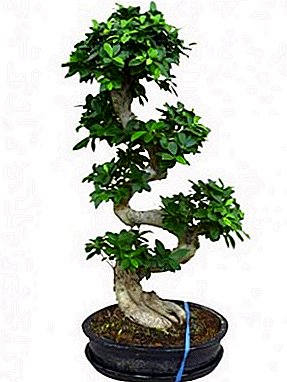 Ficus microcarp is not only an interior decoration, but also a very useful plant.
Ficus microcarp is not only an interior decoration, but also a very useful plant.
Eating tree effectively heals the microclimate in the house, cleaning the air from such harmful substances as phenol, benzene and trichlorethylene.
In addition, it has numerous healing properties.
Tinctures and preparations made from the milky juice and leaves are used to treat mastopathy and various neoplasms.
With the help of ficus you can get rid of wen, warts and hematomas.
Also funds from it help with arthritis, osteochondrosis and radiculitis. The tree is not poisonous and completely safe.
Ficus ginseng deserves to stay in your home for a long time.
With proper care at home for a ficus "Ginseng" tree can not only become an elegant decoration, but also clean the air in the room.







